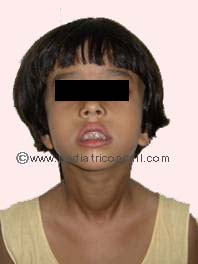Dr Ira Shah.
Medical Sciences Department, Pediatric Oncall, Mumbai, India.
ADDRESS FOR CORRESPONDENCE
Dr Ira Shah, 1/B Saguna, 271/B St. Francis Road, Vile Parle (W), Mumbai 400056. | | Abstract | | Grave's Disease is the commonest cause of hyperthyroidism in children especially between 11-15 years of age and has a female predilection. Patients present with motor hyperactivity, emotional lability, short attention span, tremors, voracious appetite with no increase in weight, exophthalmos, smooth flushed skin with excessive sweating, tachycardia, palpitations, cardiac enlargement and in long standing cases a goiter. We present a child of 4 years of age who had Grave's disease. | | | | Introduction | | Grave's disease is an autoimmune disease. It is also called exophthalmic goiter. Graves' disease may present clinically with one of the following characteristic signs: exophthalmos, pretibial myxedema, fatigue, weight loss with increased appetite, and other symptoms of hyperthyroidism like rapid heart beats and muscular weakness (1). Thyroid-stimulating immunoglobulins (TSIs) bind to and activate thyrotropin receptors, causing the thyroid gland to grow and the thyroid follicles to increase synthesis of thyroid hormone (2). We present a child of 4 years of age who had Grave's disease. | | | | Case Report | A four-year-old female child born of non-consanguineous marriage presented with increased precordial activity and breathlessness on exertion since 8 months. She had increased frequency of stools, progressive swelling over anterior part of neck with edema feet and hands since 3 weeks. She had a history of generalized tonic convulsion 3 weeks back. 8 months back she was investigated for the same and detected to have sinus tachycardia (heart rate = 140 beats/min). 2D Echo was normal. 3 weeks back, she was admitted for her convulsion and again detected to have sinus tachycardia. Her CT brain, USG Abdomen, hemogram, renal function tests, renal function tests, RA factor, X-Ray Chest were normal. EEG revealed multifocal discharges. Thyroid function tests had normal T3 & T4 levels with subnormal TSH. She was discharged on Sodium valproate, clobazam and iron supplements.
On presentation, she had tachycardia (heart rate = 150/min) with normal BP (120/80 mm of Hg). There was exophthalmos with non-pitting pedal edema, diffuse enlargement of thyroid gland and matted cervical lymphadenopathy on the right side of the neck. She had no tremors. Other systemic examination was normal. She was diagnosed as a case of Hyperthyroidism with goiter and tachycardia. Her investigations revealed normal hemogram and increased thyroid hormones with decreased thyroid stimulating hormone [T3 > 800 ng/dl (Normal = 70-200 ng/dl), Free T3 = > 20 pg/ml (Normal = 1.7-4.2 pg/ml), T4 > 24 mcg/dl (Normal = 4.5-13 mcg/dl), Free T4 > 12 ng/dl (Normal = 0.7-1.8 mg/dl), TSH < 0.01 mIU/ml (Normal = 0.3-5.5 mIU/ml)] suggestive of primary hyperthyroidism. Her antimicrosomal antibody levels were elevated (1:320) while antithyroglobulin antibody was negative. Ultrasound of the thyroid gland revealed enlarged thyroid lobes with increased vascularity and multiple cervical lymphadenopathy. There was no nodularity. Mantoux test was negative. Thus she was diagnosed as Grave's Disease. She was treated with propanolol (2 mg/kg/day), carbimazole (5 mg/kg/day) and continued on antiepileptics. After a week on the above therapy, her heart rate had decreased to 110 beats/min and her cervical lymphadenopathy had started regressing.
 | | | | Discussion | | Grave's Disease (Diffuse toxic goiter of thyroid gland) is the commonest cause of hyperthyroidism in children especially between 11-15 years of age and has a female predilection. Patients present with motor hyperactivity, emotional lability, short attention span, tremors, voracious appetite with no increase in weight, exophthalmos, smooth flushed skin with excessive sweating, tachycardia, palpitations, cardiac enlargement and in long standing cases a goiter. (1) Etiology is postulated to be failure of T suppressor cells which leads to increased T helper cells which activate B cells to form thyrotropin receptor stimulating antibody (TRS Ab) leading to stimulation of T3 & T4 secretion (3). Grave's disease may be associated with conditions such as Type 1 Diabetes Mellitus, Addison's disease, Vitiligo, Pernicious anemia, Alopecia areata, Myasthenia Gravis & Celiac disease (3). Laboratory investigations would reveal elevated serum levels of thyroxine (T4), triiodothyronine (T3), free T4 and free T3. Levels of TSH are suppressed. TRS Ab is positive which disappear on remission of the disease (3). Treatment consists of antithyroid drugs. (Methimazole is 10 times more potent than propylthiouracil (PTU) with longer serum half-life and can be given once daily). PTU is preferred in pregnant and lactating mother as it does not cross placenta or pass into breast milk. Antithyroid drugs can cause leucopoenia, urticarial rash, hepatitis, glomerulonephritis & lupus-like reaction and thus have to be monitored for same. Drug therapy may be required for 5 years or longer. Beta-adrenergic blocking agent- propanolol is useful in severely toxic patients. Surgery or radioiodine treatment is indicated when medical management fails or severe side effects of antithyroid drugs occur. Radioiodine is a safe alternate therapy in children over 10 years of age. (4) | | | | Compliance with Ethical Standards | | Funding None | | | | Conflict of Interest None | | |
- Behram RE, Kliegman RM, Jenson HB, Nelson's Textbook of Pediatrics, 17th edn. Philadelphia, W.B. Saunders, 2004:1884-1886.
- Burch HB, Wartofsky L. Life-threatening thyrotoxicosis. Thyroid storm. Endocrinol Metab Clin North Am. 1993; 22: 263-277. [CrossRef]
- Wallaschofski H, Kuwert T, Lohmann T. TSH-receptor autoantibodies - differentiation of hyperthyroidism between Graves' disease and toxic multinodular goiter. Exp. Clin. Endocrinol. Diabetes. 2004; 112: 171–174. [CrossRef]
- Franklyn JA. The management of hyperthyroidism. N Engl J Med. 1994; 330: 1731-1738. [CrossRef]
|
| Cite this article as: | | Shah I. GRAVES DISEASE. Pediatr Oncall J. 2005;3: 49. |
|